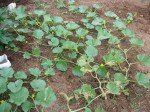 Whether you like to eat cumbers in salad or as pickles, cucumbers are a rewarding crop. Many are large and take up a lot of garden space but you can grow them on a trellis or select a bush variety if space is a problem. Cucumber salad, cucumber dressing, or dill pickles are so much tastier when you grew the cucumbers yourself.
Whether you like to eat cumbers in salad or as pickles, cucumbers are a rewarding crop. Many are large and take up a lot of garden space but you can grow them on a trellis or select a bush variety if space is a problem. Cucumber salad, cucumber dressing, or dill pickles are so much tastier when you grew the cucumbers yourself.
Here are some suggestions for growing cucumbers.
1. Chose the variety that best meets you needs. If you only want to eat them in salads choose slicers. If you want to make pickles, choose picklers, but it you want to do both choose picklers because they are just as good as slicers in salad. Don’t try to pickle slicers, the results will not be satisfactory. Your next choice involves space; how much garden space do you have for cucumbers? You may be able to accommodate vines but on the other hand you may want to opt for bush varieties. For more on choosing cucumbers read my post on “How to Select Cucumbers for the Vegetable Garden”.
2. Prepare the soil. Add a 4-6” layer of compost or well rotted manure to the planting bed. If you can not do this, apply 5-10-10 fertilizer to each plant at the time of planting (and again as mentioned below).
3. Plant cucumbers in the garden when the soil is at least 60oF. If you live in areas with a short growing season (USDA Zones 3-4) you might want to start seedlings 3-4 weeks before your last frost date or buy seedlings. Alternatively, you can hasten the warming of the soil by covering it with black bags to soak up the sun’s warmth. When the soil is warm, plant 4-6 seeds 1” deep 2-3” apart in a row and thin to 12” apart. If you want to grow cucumbers in hills, plant 4-5 seeds in a circle and thin to two plants per circle after germination.
4. Water deeply and keep the soil evenly moist. Check the moisture level in the soil by digging down 6” with a trowel. Mulch the plants to conserve moisture. Overhead watering is not recommended because it encourages mildew so if it is your only choice water early in the day so the leaves can dry quickly and before dark. The best way to water is to dig a furrow around the hill or along the row of cucumbers and flood the furrow. In order to create a workable furrow you will have to train the vines to grow in one direction or the vines will grow in the furrow and clog it.
5. Fertilize every 3-4 weeks. Scatter a complete fertilizer in the furrow mentioned in #4 and water in.
6. Check the plants for cucumber beetles and remove them. The adults especially like the leaves of young plants but they also spread bacterial wilt, a fatal disease with no cure. The larvae of the beetle eat the roots. Physically remove the beetles or dust with Sevin.
7. Harvest while cucumbers are small. For slicers that is about 6”, for picklers, about 4’. Once they start to turn yellow pick the cucumbers and throw them away so that the plant will continue to produce flowers and fruit.
Six to twelve vines will give a family plenty of picking opportunities. Short on space? Grow the vines on a trellis or try a compact variety. There are some, like ‘Salad Bush’ that can be grown in 2 square feet. Just be sure to include plenty of compost or well-rotted manure in the potting mix, feed, and water frequently.
